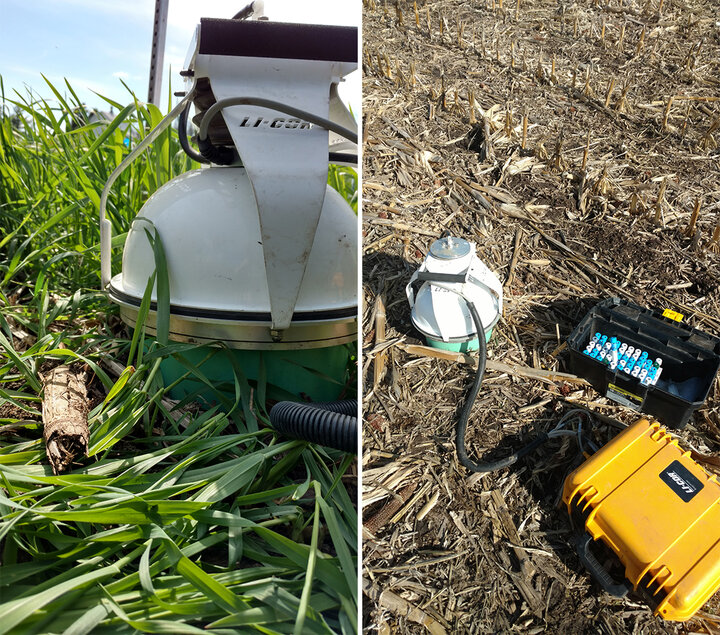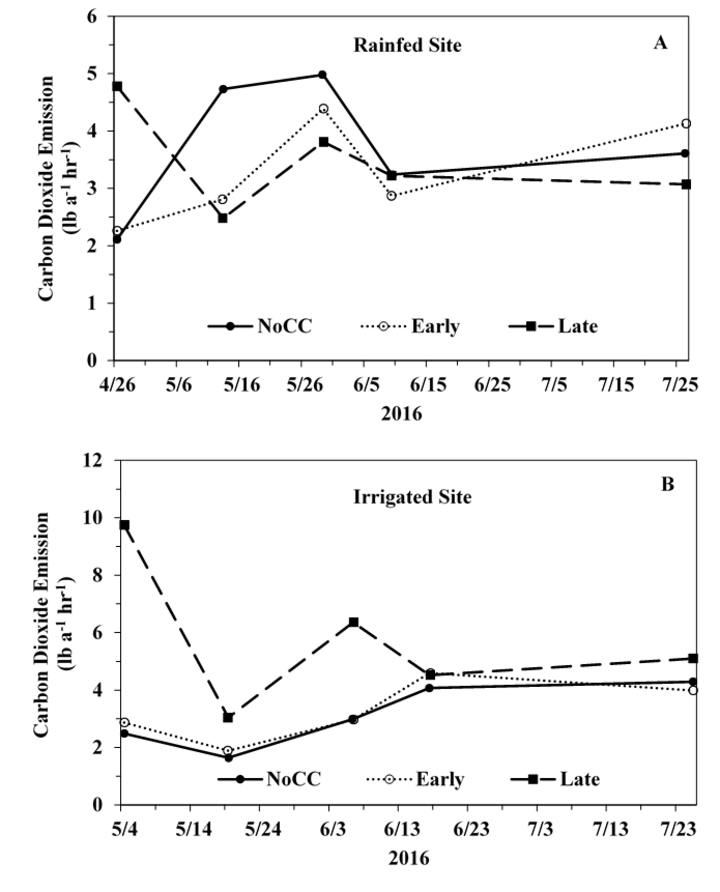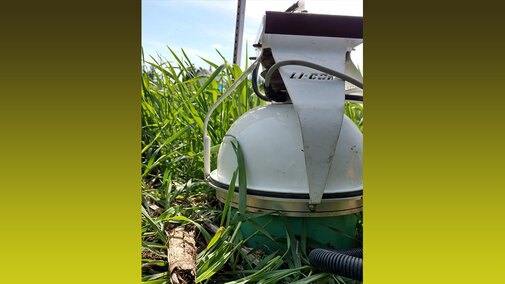Agricultural land management practices account for about 50% of soil organic carbon (SOC) loss. Restoring SOC is important to soil productivity and fertility. Management strategies to rebuild SOC include
- adding manure or other organic amendments,
- increasing root biomass from crops,
- leaving crop residues on the field,
- reducing soil disturbance, and
- using cover crops.
Using cover crops during the off-season is an opportunity to build SOC through added input of fresh residue carbon (C) into the soil. The input of fresh organic matter from cover crops may enhance soil biological activity and other soil processes, which can contribute to the decomposition of aboveground and belowground biomass. The decomposition of organic matter occurs through microbial activities and results in emission of CO2 from the soil. Stimulation of biological activity due to microbial activity could result in increased CO2 emissions and losses of SOC. One question regarding cover crop effects on SOC dynamics and storage is: Does the use of cover crops alter net carbon dioxide (CO2) emissions from the soil?
Importance of CO2 Emissions
Soil CO2 emissions (or soil respiration) are an indicator of soil microbial and plant root activity. Soil microbes are diverse and perform vital functions in the soil. Many soil microbes use C from soil organic matter as their food or energy source. Through the use of microbial enzymes, microbes decompose and use organic matter, resulting in CO2 emissions. Microbial breakdown of organic matter not only releases CO2 but also releases essential nutrients such as nitrogen (N), phosphorus (P), and others for plant uptake. Thus, CO2 emissions are an important process for nutrient cycling.
Impacts of Cover Crop on Soil CO2 Emissions
Previous studies on the impacts of cover crops on CO2 emissions have shown mixed effects, primarily due to differences in cover crop biomass production. Cover crops may not affect CO2 emissions during the growing season in temperate climates such as in the US Midwest and Central Great Plains (Negassa et al., 2015; Liebig et al., 2010; Bavin et al., 2009). Cover crops are expected to increase CO2 emissions by adding organic matter; but low cover crop biomass production at termination can result in minimal changes in CO2 emissions. According to some published studies, cover crop biomass yield of 0.10 to 2.23 tons per acre may not affect CO2 emissions while cover crop biomass yields of more than 2.23 tons per acre may increase CO2 emissions (Sanz-Cobena et al., 2014; Negassa et al., 2015; Guardia et al., 2016).
The increase in CO2 emissions with high-biomass-producing cover crops may be due to plant respiration, as cover crops are often included inside the measurement chamber as shown in Figure 1. The increased CO2 emission under cover crops may be particularly relevant during the cover crop growing period and not after cover crop termination (Sanz-Cobena et al., 2014; Guardia et al., 2016). Limited changes in CO2 emissions under cover crops may be an indicator of minimal cover crop-induced increases in SOC concentration. Studies have reported increased CO2 emissions under cover crops only when cover crops increased SOC concentration and not when SOC concentration was unaffected (Liebig et al., 2010; Kim et al., 2013; Haque et al., 2015).
Data from Nebraska

An ongoing study that started in fall 2013 began monitoring soil CO2 emissions in spring 2016 on plots located at a rainfed site in eastern Nebraska and an irrigated site in south central Nebraska under no-till continuous corn (Figure 1). The treatments were
- no cover crop,
- an early-terminated rye cover crop (30 days prior to planting corn), and
- a late-terminated rye cover crop (within a few days of planting corn).

Cover crop biomass yield at the rainfed site averaged 1.41 tons per acre for early termination and 2.90 tons per acre for late termination. At the irrigated site, average cover crop biomass yield was 0.35 tons per acre at early termination and 5.00 tons per acre at late termination. At both sites, cover crops had no effect on SOC concentration after three seasons of cover crop use. At both sites, no cover crop and early-terminated cover crop treatments generally had similar emission rates at each measurement (Figure 2). Late-terminated cover crops had CO2 emission rates nearly twice that of the early-terminated and no cover crop treatments in spring, particularly at the irrigated site. This increased emission of CO2 from the late-terminated cover crop was likely due to plant respiration.
At both sites, the late-terminated cover crop was chemically terminated about May 5. The reduction in CO2 emission in mid-May with the late-terminated cover crop reflects termination of the cover crop (Figure 2). The increase in CO2 emission in late May partially reflects the microbial breakdown of cover crop residues. The similarities in emission rates by summer suggest that cover crop effects on CO2 emissions are ephemeral may be overshadowed as crop growth increases and dominates the system. Our data are consistent with previous studies that showed cover crop effects on CO2 emissions are primarily linked to the amount of cover crop biomass produced.
Conclusions
Cover crops terminated when relatively small (less than 2 tons per acre of biomass yield) appear not to affect CO2 emissions. However, late-terminated cover crops with higher biomass production can increase CO2 emissions, most likely due to plant respiration. Based on the results of our Nebraska study, termination time of cover crops can affect CO2 emissions on a short-term basis compared to early-terminated cover crops or no cover crop. While cover crops can increase SOC, reduce erosion risks, and reduce nutrient loss, in the carbon-rich soils of this study, cover crops did not significantly impact SOC or CO2 emissions. Overall, our study showed that cover crop effects on CO2 emissions are linked to cover crop biomass production and are generally confined to the cover crop growing period.
References
Bavin, T.K., T.J. Griffis, J.M. Baker, and R.T. Venterea. 2009. Impact of reduced tillage and cover cropping on the greenhouse gas budget of a maize/soybean rotation ecosystem. Agriculture, Ecosystems & Environment 134:234-242.
Haque, M.M., S.Y. Kim, M.A. Ali, and P.J. Kim. 2015. Contribution of greenhouse gas emissions during cropping and fallow seasons on total global warming potential in mono-rice paddy soils. Plant and Soil 387:251-264.
Kim, S.Y., J. Gutierrez, and P.J. Kim. 2012. Considering winter cover crop selection as green manure to control methane emission during rice cultivation in paddy soil. Agriculture, Ecosystems and Environment 161:130-136.
Liebig, M.A., D.L. Tanaka, and J.R. Gross. 2010. Fallow effects on soil carbon and greenhouse gas flux in central North Dakota. Soil Science Society of America Journal 74:358-365.
Negassa, W., R.F. Price, A. Basir, S.S. Snapp, and A. Kravchenko. 2015. Cover crop and tillage systems effect on soil CO2 and N2O fluxes in contrasting topographic positions. Soil Tillage Research 154:64-74.
Sanz-Cobena, A., S. Garcia-Marco, M. Quemada, J.L. Gabriel, P. Almendros, and A. Vallejo. 2014. Do cover crops enhance N2O, CO2, or CH4 emissions from soil in Mediterranean arable systems? Science of the Total Environment 466-467:164-174.

